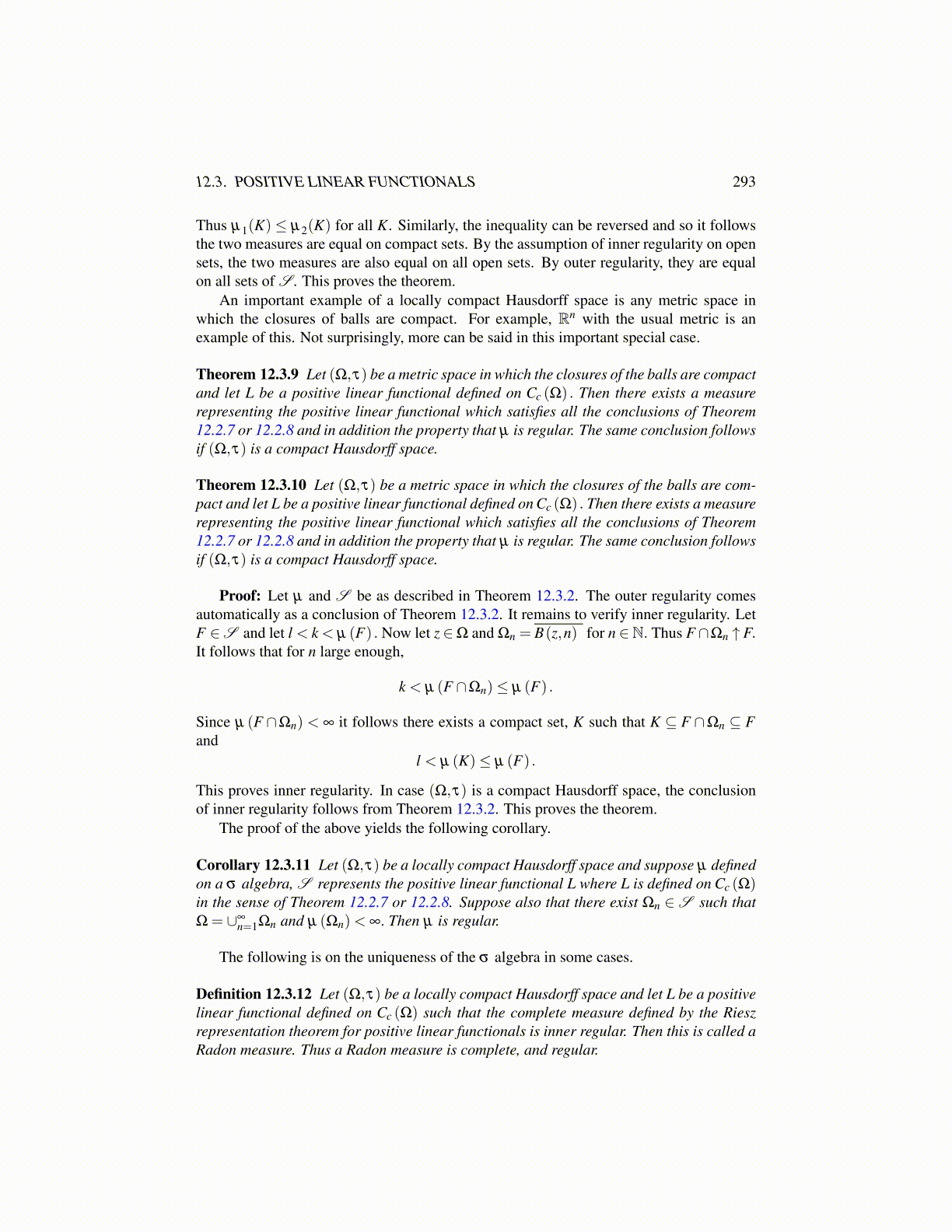
12.3. POSITIVE LINEAR FUNCTIONALS 293
Thus µ1(K)≤ µ2(K) for all K. Similarly, the inequality can be reversed and so it followsthe two measures are equal on compact sets. By the assumption of inner regularity on opensets, the two measures are also equal on all open sets. By outer regularity, they are equalon all sets of S . This proves the theorem.
An important example of a locally compact Hausdorff space is any metric space inwhich the closures of balls are compact. For example, Rn with the usual metric is anexample of this. Not surprisingly, more can be said in this important special case.
Theorem 12.3.9 Let (Ω,τ) be a metric space in which the closures of the balls are compactand let L be a positive linear functional defined on Cc (Ω) . Then there exists a measurerepresenting the positive linear functional which satisfies all the conclusions of Theorem12.2.7 or 12.2.8 and in addition the property that µ is regular. The same conclusion followsif (Ω,τ) is a compact Hausdorff space.
Theorem 12.3.10 Let (Ω,τ) be a metric space in which the closures of the balls are com-pact and let L be a positive linear functional defined on Cc (Ω) . Then there exists a measurerepresenting the positive linear functional which satisfies all the conclusions of Theorem12.2.7 or 12.2.8 and in addition the property that µ is regular. The same conclusion followsif (Ω,τ) is a compact Hausdorff space.
Proof: Let µ and S be as described in Theorem 12.3.2. The outer regularity comesautomatically as a conclusion of Theorem 12.3.2. It remains to verify inner regularity. LetF ∈S and let l < k < µ (F) . Now let z ∈Ω and Ωn = B(z,n) for n ∈N. Thus F ∩Ωn ↑ F.It follows that for n large enough,
k < µ (F ∩Ωn)≤ µ (F) .
Since µ (F ∩Ωn) < ∞ it follows there exists a compact set, K such that K ⊆ F ∩Ωn ⊆ Fand
l < µ (K)≤ µ (F) .
This proves inner regularity. In case (Ω,τ) is a compact Hausdorff space, the conclusionof inner regularity follows from Theorem 12.3.2. This proves the theorem.
The proof of the above yields the following corollary.
Corollary 12.3.11 Let (Ω,τ) be a locally compact Hausdorff space and suppose µ definedon a σ algebra, S represents the positive linear functional L where L is defined on Cc (Ω)in the sense of Theorem 12.2.7 or 12.2.8. Suppose also that there exist Ωn ∈S such thatΩ = ∪∞
n=1Ωn and µ (Ωn)< ∞. Then µ is regular.
The following is on the uniqueness of the σ algebra in some cases.
Definition 12.3.12 Let (Ω,τ) be a locally compact Hausdorff space and let L be a positivelinear functional defined on Cc (Ω) such that the complete measure defined by the Rieszrepresentation theorem for positive linear functionals is inner regular. Then this is called aRadon measure. Thus a Radon measure is complete, and regular.